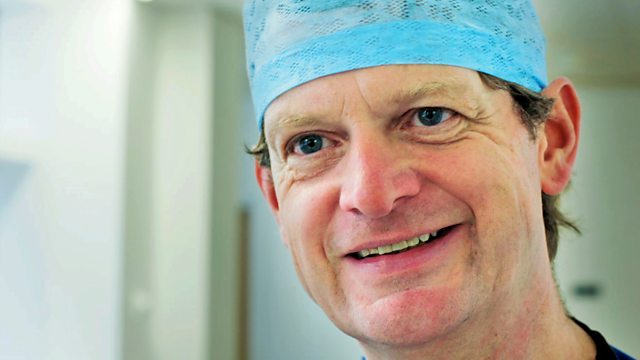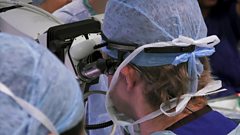Pushing The Boundaries
Maxillofacial surgeon Tim Martin operates on a woman with a disease so rare, he is thought to be the first in the UK to attempt the procedure.
At the Queen Elizabeth Hospital Birmingham, around 700 operations are carried out every week, across 42 specialist theatres. Most patients have conditions that are familiar to experienced surgeons, but occasionally the teams must tackle much rarer and more challenging cases.
Consultant maxillofacial surgeon Tim Martin and his operating partner Sat Parmar are planning a marathon operation on former police officer Loretta. As far as they can tell from medical records, they will be the first UK surgeons to operate on the strange disease Loretta is suffering from.
Nine months earlier, Loretta appeared in Tim’s clinic with a mysterious condition that was destroying the bones and muscles in one side of her face, causing her mouth to fuse shut. After much detective work, the team arrived at a diagnosis of tumefactive fibroinflammatory disease – a condition so rare, Tim could only dig up some 50 documented cases worldwide.
As all non-surgical treatments, including chemotherapy, have failed to halt the damage being done by the disease, and Loretta is now at serious risk of a fatal stroke, Tim is left with only one option: major surgery to remove the diseased area, followed by complex facial reconstruction. But operating without established medical protocol, on diseased tissue with unknown characteristics, makes Tim very uncomfortable.
The procedure involves radical surgery to the entire left-hand side of Loretta’s face, and means she will lose a section of her upper jaw, as well as facial muscles that have tough and hardened. It is a daunting prospect for both patient and surgeon. Having come to consider Loretta a friend during the lengthy period planning the surgery, Tim feels even more pressure than usual to get a good result.
Removing the diseased area will save Loretta’s life, but the surgeons know it will be devastating for her if she is left badly disfigured. To give her best possible outcome, they intend to fill the cavity left in her face with a section of bone and muscle removed from her hip.
They will draw on the Queen Elizabeth’s on-site maxillofacial prosthetics laboratory. Here technicians have adapted the latest 3D design techniques to transform patient scans into bespoke 3D-printed cutting guides. In theatre, these enable the surgeons to cut out the correct amount of bone from the face, and also cut a graft from the hip bone that will then slot into the hole in the face with total precision. This absolute accuracy has transformed the success rates for surgery, and achieves better cosmetic results for patients.
During the all-day procedure, it isn’t long before the disease’s unpredictable characteristics put the team under severe pressure. Tim must keep working methodically in spite of the stress he feels when a bleed from a ruptured blood vessel that would usually be simple to control becomes a major challenge, due to the effects of Loretta’s unusual condition.
The programme also features consultant neurosurgeon Alex Paluzzi, who is taking on one of the toughest cases of his career too. His patient, 64-year-old Norah, fractured her neck while on a fairground ride with her grandchildren. A scan revealed that she had a rare and aggressive tumour called a clival chordoma, which had not only weakened the bones of her neck, but also wrapped itself around her brainstem – putting her life in imminent danger. As it is located in the area where all the nerves of the body plug in to the brain, attempting to remove the tumour surgically is fraught with danger. The big question Alex faces is, will operating cause more harm than good?
Hoping for the best, Norah gives the go ahead, so Alex attempts two approaches, tackling the tumour first from the front via the nose, then from the rear. In order to reach the 'enemy', Alex has to remove a 'window' of skull bone from behind Norah’s ear and then navigate a series of vital nerves without damaging them – if he does Norah may lose her ability to speak or breathe. He describes it as being like ‘operating through prison bars’.
With exceptional access to surgeons, anaesthetists, theatre staff and their patients, and filmed with specialist fixed-rig cameras, head-cams and microscope feeds, Surgeons: At the Edge of Life offers a unique insight into the sort of person it takes to be a surgeon taking responsibility for the most demanding procedures possible.
Last on
More episodes
Previous
Clip
-
![]()
Rejoining arteries with stitches thinner than hair
Duration: 01:14
Credits
| Role | Contributor |
|---|---|
| Series Producer | Katharine Patrick |
| Executive Producer | Ruth Shurman |
| Executive Producer | Richard Bond |
| Editor | Michelle Bromham |
| Editor | Jacob Finbow |
| Editor | Simon Mason |
| Production Manager | Debbie Vile |
| Production Manager | Louisa Hatfield |
| Producer | Nabila Hussein |
| Composer | Mat Davidson |
| Narrator | Shaun Dooley |
Broadcasts
- Tue 16 Apr 2019 21:00
- Thu 9 May 2019 01:15


